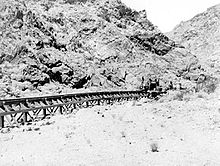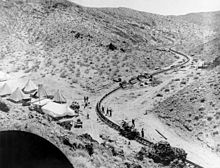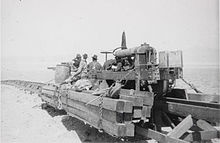Epsom Salts Monorail
The Epsom Salts Monorail or Magnesium Monorail was a California monorail from Magnesia on the Trona Railway through Layton Canyon and over Wingate Pass to the Epsom Salt Mine in the Owlshead Mountains southwest of Death Valley . It was built from 1922 to 1924 by Thomas Wright, a florist from Los Angeles , after he discovered salt deposits there.
history
During World War I , Thomas Wright and his investors set up camp in Crystal Hills Wash and prepared the site for salt mining. Some of their supplies had to be delivered by truck from Randsburg, 63 km away, without suitable routes . The construction of a railway line was considered, but discarded because of the cost of leveling the uneven terrain. Therefore Thomas Wright decided to build a monorail on wooden supports.
The construction work was carried out by the American Magnesium Company, founded by Thomas Wright. For the construction of the pillars, Douglas fir was brought to San Pedro by ship and then by train via Mojave to Searles station . From there, it was with the Trona Railway for siding made of magnesia. To operate the monorail, a shunting track was laid. In September 1923, 25 of the 45 kilometers had already been completed.
The monorail was completed and inaugurated in 1924. It became known as the "fastest monorail in the world" because it covered the 45 km long route fully loaded within an hour shortly after commissioning. Over the next two years, the monorail transported less salt to the siding than originally planned, from where it was brought to the American Magnesium Company's factory in Wilmington , California .
In 1924/25 12–15 employees worked in the mine . In the beginning, the epsomit could easily be removed from the ground with a garden hoe. But the occurrence of the high quality mineral was limited and it turned out to be contaminated with 50% admixtures. The profitability of salt mining suffered from the high costs of maintaining the wooden structure, which warped as it dried, from inadequate locomotives and dust avalanches that damaged parts of the route, so that the mine was closed in June 1926. Since no buyers were found until 1928, only a small part of the investment of about one million US dollars could be saved in the liquidation of the company.
Route and construction
The railway line ran from the siding in Magnesia over the dry bed of Searles Lake . It climbed 548 meters in altitude on a 7.5 km long route with an incline of 7% over Layton Canyon. It crossed Layton Pass and then descended through a narrow canyon to the bottom of the Panamint Valley with only one road crossing on the route. On the other side of the valley it rose with a gradient of 10-12% to Wingate Pass, then along the Wingate Wash and the Crystal Hills Wash and finally in a south-westerly direction to the camp and the mine.
This route made a conventional adhesion railway line impossible because of the steep gradients. Since monorails were considered very promising at the time, they seemed ideal for the route to the lonely mine. Thomas Wright built and tested a model and applied for patents on it.
At the end of 1922, construction work began on the real route. A wooden central beam with a cross section of 15 × 20 cm was supported by several wooden supports, which were set up about 2.50 m (8 feet ) apart . A conventional steel rail with a weight of 25-40 kg / m was laid on top. Cross boards were attached to the uprights in order to attach 5 × 15 cm guide rails for lateral guidance.
vehicles
The vehicles had rectangular steel frames in which a double flange wheel ran at each end. To balance the vehicle, there were spring-loaded steel parts with 20 cm wide rollers with a 20 cm diameter. Between vehicles were clutches in the trams of Los Angeles had been scrapped.
The cargo was stowed in bins on either side of the wagons, with a low center of gravity like the saddlebags of mules. The locomotives had a similar structure to the wagons. The first locomotive used during construction was battery-powered. But since it was too weak to pull loaded trains, Fordson tractors were converted as drive vehicles. Initially without joints, the drive was heavily loaded in curves, so that later a chain drive was provided. A total of eight locomotives were used on the line, seven of them with Fordson engines and one later built with a more powerful Buda engine.
There were only brakes on the locomotive, which constantly led to problems in operation. Each locomotive could be loaded with a maximum of 1500 kg, while the wagons could be loaded with 3900 kg. The top speed was 56 km / h, and 48 km / h were achieved on the flat.
remains
At the end of the 1930s, the monorail was dismantled, only the A-frames remained in the desert. Some of them disappeared over the years in the campfires of the desert visitors or as souvenirs. Most of the route is now in the restricted military area of the China Lake Naval Weapons Center "B" Range. The mine, on the other hand, is located on the grounds of Death Valley National Park and is accessible via an entrance at the Fort Irwin Army Base near Tecopa .
The siding on the Trona Railway can be reached via a dirt road that leads north from an intersection on California Highway 178 to the Trona Pinnacles. Freight wagons are usually parked there so that it is easy to find. There are still heavy concrete foundations and ruins of previous residential buildings in the area.
Web links and literature
- David F. Myrick: Railroads of Nevada and Eastern California: The southern roads. University of Nevada Press, 2007. Pages 808-813.
- John Anson Ford: A Wealth of Death Valley with Monorail. In: Popular Mechanics, July 1923, Volume 40, No. 1. Edited by Hearst Magazines. ISSN 0032-4558 .
- Richard H. Jahns: The Epsom Salts Line - Monorail to Nowhere.
- DzrtGrls: Hike to the Epsom Salts Mine and Monorail.
Individual evidence
- ^ A b c Virtual Transportation Museum, a Division of the Eastern California Museum: Epsom Salts Monorail.
- ↑ a b c d e f g h David A. Wright: Epsom Salts Monorail Railroad Picture Collection. Frontier Trails of The Old West.
- ↑ Patent Application US1454804.
Coordinates: 35 ° 40 ′ 53.1 ″ N , 117 ° 23 ′ 29 ″ W.




